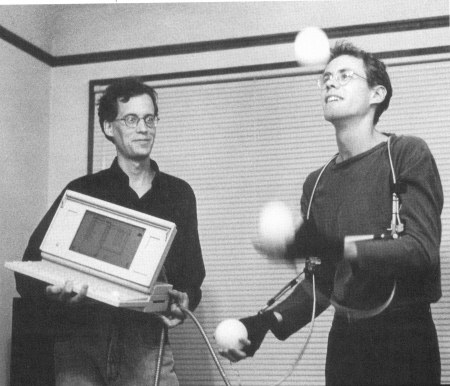
Collaborator Bret Battey and James Jay created the Juggling Jukebox. (Photo by Lincoln McNey) |
Page 26 Spring 1996
|
"Is
it real?" As
Last
fall James Jay and I arranged to conduct a real-time, online interview
over the Internet (using Unix's "talk" facility, for the
techno-savvy). This Performance
History JW:
How did you get into juggling originally? JJ:
I learned juggling as an undergraduate at Earlham College (Class of
'90) in Richmond, lnd. I suppose learning juggling in college isn't
that unusual, but I actually learned in a juggling class, for credit,
which is a bit odd.
JW:
What were you majoring in, and how did you decide to take the
juggling class? JJ:
I majored in English literature. Earlham is a very academically
conservative school, but for some reason they had a physical education
requirement. A student organized a juggling class as one of the
"Sport and Movement Studies" options.
JW:
How did the idea of the "Juggling Jukebox" first occur to
you? JJ:
After moving to Seattle in 1990, I was trying to think of a way for a
juggling act to work at Pike Place Market. The market is the place for
street performing in Seattle, but the spaces are very small, so a
traditional juggling act doesn't work. I had been thinking about what
would work in a confined space, and
JW:
What "robotic thing?" JJ:
A lot of young black men stand on the waterfront with music playing
from boom-boxes. They will stand with a cup out and do some robotics
when you put money in their cup. The more money, the longer the
performance. So there are some precursors that I owe part of the idea
too, but I have never seen
JW:
Had you done much performing before the Jukebox? JJ:
At the Pike Place Market Festival, I had a paid gig performing in
the Kid's Alley. That went alright, but it was pretty much like other
juggling acts. As I was exploring the idea of getting out and street
performing, I realized that the traditional street act didn't really
play well with my strengths. By nature, I'm somewhat reserved, so the
Juggling Jukebox (which is totally silent) worked well for me. It's
very focused, so I could practice the specific mime skills that I
needed. It concentrates on showing tricks, which is what most jugglers
work on but most acts squeeze in between the jokes. So I could use my
juggling
JW:
How did this evolve into the high-tech version? JJ:
After I had been performing the original (low-tech) Jukebox for a bit
over two years, I came across a grant offered by 911 Media Arts
(a Seattle-based center for the development of the artistic
application of broadcast, video and communication technologies). They,
along with a group called Northwest Cyberartists were putting on an
art and technology festival and conference called "Beyond Fast
Forward." I had another idea for a street performing stage JW:
What is the relationship between the high-tech Juggling Jukebox
and other hightech juggling acts such as the Karamazovs body suit
routine and Dan Menendez's bounce piano routine? JJ:
The Juggling Jukebox is unique in that it uses computer readings
of movement as well as hits. Every other high-tech juggling routine
uses a ball hitting a drum pad, keyboard key, or body trigger. The
high-tech Jukebox uses triggers on my palms, but also measures the
movement in my elbow. I see this as expanding the possibilities
significantly - instead of a 0 or 1, you're receiving a value between
0 and 255, so you can control pitch, volume, tempo, anything that's
not a simple on/off value. This permits a much richer set of
responses. |

Collaborator Bret Battey and James Jay created the Juggling Jukebox. (Photo by Lincoln McNey) |